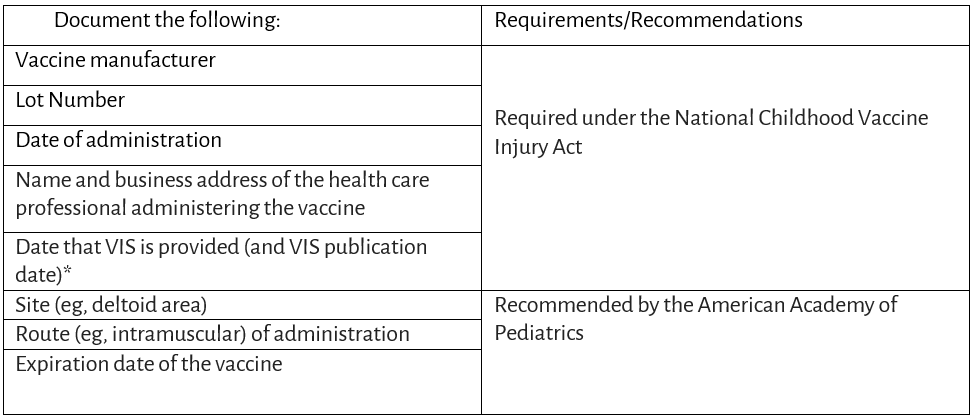You will want to administer immunizations correctly, so your patients can safely develop immunity. This page will also help you document immunization properly.
7 Rights of Vaccine Administration
Know and practice the 7 rights of vaccine administration to prevent vaccine administration error:
- The right patient
Screen all patients for contraindications and precautions every time a vaccine is administered, even if the patient has previously received a dose of that vaccine. Screening questions are available here. -
The right time
Check the schedule to ensure the patient is getting the vaccine at the right time, and the appropriate interval (Log-in required). Each vaccine vial and diluent should be checked for the expiration date as an expired vaccine should never be used. Once reconstituted, the vaccine must be administered according to the guidelines or discarded. -
The right vaccine or diluent
Some vaccines need to be reconstituted; a specific diluent will be provided by the manufacturer. Follow manufacturer guidelines in reconstituting the vaccine. See Vaccines with Diluents: How to Use Them. Measles, mumps, rubella (MMR); varicella; zoster; meningococcal polysaccharide (MPSV); and rotavirus vaccines all require reconstitution. - The right dosage,
- The right route, needle length, and technique, &
- The right site
The correct amount of vaccine should be drawn when drawing from multidose vials. Vaccines should be administered through the appropriate route (intramuscular (IM), subcutaneous (SQ), oral, and intranasal), and administered to the right site on the child. See Administering Vaccines: Dose, Route, Site, and Needle Size. - The right documentation

*Required by Centers for Disease Control and Prevention (CDC) regulations for vaccines purchased through CDC contract. See the VIS Web site for current versions.
Other important vaccine administration tips:
Dos
- Do use a separate anatomic site for each injection.
- Do label vaccines if more than one are drawn up together. This will help with documenting which vaccines were given in which site.
- Do ensure that the person who drew up the vaccine administers it. This will reduce errors.
- Do wash hands between patient encounters and before preparing vaccines.
- Do wear gloves to administer a vaccine if there is a risk coming into contact with body fluids or if the administrator has open sores or cuts on the hands.
- Do consider immunizations for those with only a mild illness. If a child has a moderate or severe illness – reschedule their immunizations.
- Do always screen for other contraindications.
- Do use safety syringes to reduce the incidence of needle sticks and disease transmission.
- Do check to see what size needle, route and location should be used.
Don'ts
- Do not mix separate vaccines in the same syringe. If more than one vaccine is being administered to the same limb, injection sites should be 1 to 2 inches apart so that any reactions can be determined.
- Do not pre-draw your own syringes – these are vaccines that are drawn up in syringes and laid out at the beginning of the day or significantly before administration. It is ok to use prefilled syringes that come as single doses from the manufacturer.
Consider
Children and babies under the age of 3 may put a bandage in their mouth, which could result in choking. When immunizing children under 3 years of age, consider the following:
- Hold gauze on the immunization site until any bleeding stops. Do not bandage.
- Advise parents of choking risk from bandage; suggest it be removed as soon as possible.
Vaccine Administration Resources
- AAP Red Book: General Instructions for Vaccine Administration (Login required)
- Administering Vaccines: Dose, Route, Site, and Needle Size
- IAC How to Administer Intramuscular (IM) Vaccine Injections and How to Administer Subcutaneous (SC) Injections
- IAC Vaccines with Diluents: How to Use Them
- IAC Administering Vaccine Clinic Tools
- CDC Vaccine Administration Resource Library
- CDC Safety Checklist
Vaccine Administration Videos
Last Updated
08/11/2021
Source
American Academy of Pediatrics